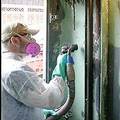 美國辛辛那提大學一群環境與職業健康專家發現,印度、中國與馬來西亞3個國家,仍繼續生產並販售含有高濃度鉛的危險塗料,這類危險產品甚至應用在兒童遊樂設施上。來自於美國、馬來西亞、印度與新加坡等4國的研究人員指出,含鉛塗料會造成全球性的健康威脅,因此急需全球性的禁令,以進一步保障公眾健康。
美國辛辛那提大學一群環境與職業健康專家發現,印度、中國與馬來西亞3個國家,仍繼續生產並販售含有高濃度鉛的危險塗料,這類危險產品甚至應用在兒童遊樂設施上。來自於美國、馬來西亞、印度與新加坡等4國的研究人員指出,含鉛塗料會造成全球性的健康威脅,因此急需全球性的禁令,以進一步保障公眾健康。
塗料添加重金屬鉛,主要是為了增加其耐久度與光澤,常用於住宅、建築物或橋樑等不鏽鋼結構物;一些自境外輸入美國的常用消費性產品,如糖果、傳統藥材、陶製餐具、含金屬玩具或小飾品等,也可發現含鉛成分。不過,鉛卻可能損害腦力與兒童發育。
1978年,基於研究證實鉛暴露有害人體健康,尤其是孩童健康,美國開始限制使用含鉛漆料。不過,辛辛那提大學的環境衛生專家克拉克(Scott Clark)指出,許多第三世界國家並未跟進,仍持續製造、販售含鉛塗料。
克拉克主導進行一項兩年的研究計畫,在印度、中國、馬來西亞與新加坡進行調查。他的研究團隊發現,沒有針對含鉛塗料實施管制的國家,有高達75%的民生用塗料檢測出含鉛量超過美國管制標準。相反的,在跟美國同樣實施管制的新加坡,塗料含鉛量較前述國家減少許多。
克拉克指出:「在那些未實施管制的國家,塗料製造商仍積極製造含鉛塗料,而有些情況是,供應商對不同國家提供的是類似甚至相同的產品,只是在有管制的國家減少含鉛量而已。」他補充說:「這很明顯可見,塗料商對美國以外的國家在產品安全上採取差別待遇。對我們來說,在現今這個經濟全球化的時代,這種忽視大眾健康的做法很不負責任,對這些和他們有生意往來的國家而言,將威脅這些國家的國民健康。」
 Environmental and occupational health experts at the University of Cincinnati, UC, have found that India, China and Malaysia still produce and sell consumer paints with dangerously high lead levels, even on products intended for use by children such as painted playground equipment. Researchers from four countries say that this lead-based paint production poses a global health threat, and a worldwide ban is urgently needed to avoid future public health problems.
Environmental and occupational health experts at the University of Cincinnati, UC, have found that India, China and Malaysia still produce and sell consumer paints with dangerously high lead levels, even on products intended for use by children such as painted playground equipment. Researchers from four countries say that this lead-based paint production poses a global health threat, and a worldwide ban is urgently needed to avoid future public health problems.
Linked to impaired intellectual and physical growth in children, lead is a metal used to improve the durability and color luster of paint used in homes and other buildings and on steel structures, such as bridges.
Lead is also found in some commonly imported consumer products, including candy, folk and traditional medications, ceramic dinnerware, and metallic toys and trinkets.
In 1978, the United States restricted lead content in paint after determining that people, especially young children, were being poisoned by environmental exposures to the metal.
Many Third World countries, says Scott Clark, PhD, did not follow suit, and continue to manufacture and sell lead-based paints.
Clark headed a two year study involving researchers from four countries. The scientists found that more than 75 percent of the consumer paint tested from countries without controls on lead paint had levels exceeding U.S. regulations. By contrast, in Singapore, which enforces the same lead restriction on new paint as the United States, lead levels were significantly lower.
"Paint manufacturers are aggressively marketing lead-based paints in countries without lead content restrictions," says Clark, professor of environmental health at UC. "In some cases, companies are offering the same or similar products, minus the lead, in a regulated country."
"There is a clear discrepancy in product safety outside the United States," he adds, "and in today's global economy, it would be irresponsible for us to ignore the public health threat for the citizens in the offending countries, as well as the countries they do business with."






